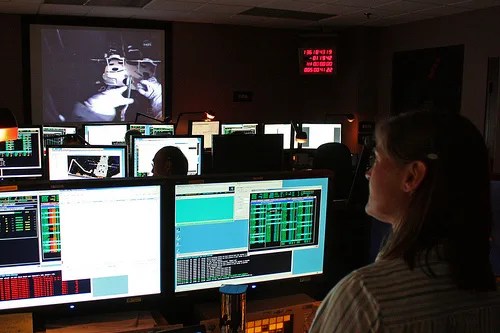4 min read

Flight Controllers at Goddard's Space Telescope Operations Control Center monitor progress during the third spacewalk of Hubble servicing mission 4. The energy and relief in the STOCC was palpable as the astronauts installed hardware and completed each milestone.
Credit:
NASA
The addition of a new science instrument and an unprecedented on-orbit repair of a severely under performing camera on Hubble highlighted Saturday activities aboard Space Shuttle Atlantis.
Mission Specialists John Grunsfeld and Andrew Feustel completed the third STS-125 spacewalk in a little over 6 ½ hours earlier today. During their time out in Atlantis’s payload bay they first removed the Corrective Optics Space Telescope Axial Replacement (COSTAR), and safely tucked it into the shuttle’s payload bay. The two then installed the new Cosmic Origins Spectrograph (COS), which will allow Hubble to peer farther into the universe than ever before in the near and far ultraviolet ranges.
Grunsfeld and Feustel then used specially designed tools to carry out a job never intended to be done on the telescope as they repaired the Advanced Camera for Surveys (ACS). The camera, known for some of the most famous imagery captured by Hubble, had stopped working in early 2007 when its backup power supply short circuited. The two removed 32 screws from an access panel to efficiently replace the camera’s four circuit boards and install a new power supply.
Engineers at Goddard have already performed “aliveness” tests on both COS and ACS to verify they have electrical power. Functional test of both instruments should be completed by early Sunday morning.
On Sunday, the “Two Mikes” as they are known – Mike Massimino and Mike Good will perform their second spacewalk of the mission. The main objective of the fourth spacewalk involves another repair effort.
The Space Telescope Imaging Spectrograph (STIS) was installed on the Hubble Space Telescope during Servicing Mission 2 in 1997. STIS stopped functioning in August 2004 due to a power supply failure.
To repair STIS, astronauts will replace a low voltage power supply board which contains a failed power converter. The repair is straightforward but requires diligence, and Hubble engineers have designed special tools for the job. If successful, the repair effort will restore one of two fully redundant electronic chains (or “sides”) of the instrument. Both were unusable after August 2004.
The basics of the task involve installing a “fastener capture plate” over the top of a STIS electronics access panel. The astronauts will use a power tool to remove the 111 fasteners (screws) that attach the panel to STIS. The plate will ensure that the small fasteners are captured without astronauts having to grasp and stash them with gloved hands. After removing the panel (with capture plate and fasteners attached), the astronauts will remove the failed power supply card and click in the new one, much like replacing a circuit board on a computer. A new, simplified panel will then be installed over the open electronics cavity – only this time 111 fasteners will not be required. By throwing only two levers, the astronauts will latch the new panel securely into place.
Massimino and good will also perform some work designed to help extend Hubble’s operating life with the installation of some new thermal material known as New Outer Blanket Layers or NOBLs.
The New Outer Blanket Layer (NOBL) covers protect Hubble’s external blankets. They prevent further degradation of the insulation and maintain normal operating temperatures of Hubble’s electronic equipment. Each NOBL has been tested to ensure that it can withstand exposure to: charged particles, X-rays, ultraviolet radiation, and thermal cycling for at least 10 years. The covers are made of specially coated stainless steel foil which is trimmed to fit each particular equipment bay door that is covered. Each cover is supported by a steel picture-frame structure. Expanding plugs, like common kitchen bottle stoppers, fit into door vent holes to allow quick installation by the spacewalking astronauts.
With completion of today’s third spacewalk, five of the top six science objectives of the servicing mission have already been met.
Ed Campion
NASA's Goddard Space Flight Center







